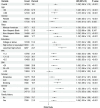The dietary inflammatory index and asthma prevalence: a cross-sectional analysis from NHANES
- PMID: 39650711
- PMCID: PMC11622817
- DOI: 10.3389/fnut.2024.1485399
The dietary inflammatory index and asthma prevalence: a cross-sectional analysis from NHANES
Abstract
Background: Inflammation is a key factor in the development of asthma, and diet significantly influences inflammatory responses. This study examines the relationship between the Dietary Inflammatory Index (DII) and asthma prevalence.
Methods: We conducted a cross-sectional analysis using data from the National Health and Nutrition Examination Survey (NHANES) from 1999 to 2018. Demographic details, anthropometric measurements, dietary habits, lifestyle factors, and asthma status were recorded for all participants. Multivariable logistic regression was utilized to assess the relationship between DII and asthma prevalence. Additionally, restricted cubic spline (RCS) analysis was employed to explore the nonlinearity and dose-response relationship between DII and asthma risk. Subgroup analyses were stratified by gender, age, race, body mass index (BMI), poverty income ratio (PIR), education, smoking status, alcohol use, and family medical history to dissect the association between DII and asthma across diverse populations.
Results: The analysis included 37,283 adults from NHANES. After adjusting for potential confounders in the multivariable logistic regression model, a significant positive association was identified between DII and asthma (OR, 95% CI: 1.05, 1.02-1.09, per 1 SD increase). The RCS analysis revealed a nonlinear association (p for nonlinearity = 0.0026), with an inflection point at 1.366, beyond which an increase in DII was significantly associated with asthma risk. Furthermore, the stratified analyses indicated a positive association between DII and asthma in the majority of subgroups.
Conclusion: The findings underscore a significant and nonlinear association between DII and asthma. To enhance asthma prevention and management, greater emphasis should be placed on modulating dietary-induced inflammation.
Keywords: NHANES; asthma; cross-sectional; dietary inflammatory index; inflammation.
Copyright © 2024 Lu and Zhu.
Conflict of interest statement
The authors declare that the research was conducted in the absence of any commercial or financial relationships that could be construed as a potential conflict of interest.
Figures



Similar articles
-
Association between dietary inflammatory index and asthmatic patients with sleep disorders in American adults, NHANES 2005-2020.J Asthma. 2025 Jul 2:1-10. doi: 10.1080/02770903.2025.2526368. Online ahead of print. J Asthma. 2025. PMID: 40574715
-
Association between dietary inflammatory index and epilepsy: findings from NHANES.Front Neurol. 2025 May 30;16:1599286. doi: 10.3389/fneur.2025.1599286. eCollection 2025. Front Neurol. 2025. PMID: 40520617 Free PMC article.
-
Dietary Inflammatory Index and Its Association with the Prevalence of Coronary Heart Disease among 45,306 US Adults.Nutrients. 2022 Oct 28;14(21):4553. doi: 10.3390/nu14214553. Nutrients. 2022. PMID: 36364813 Free PMC article.
-
Non-linear relationship between the children's dietary inflammatory index and asthma risk: identifying a critical inflection point in US children and adolescents.Front Nutr. 2025 Mar 21;12:1538378. doi: 10.3389/fnut.2025.1538378. eCollection 2025. Front Nutr. 2025. PMID: 40191798 Free PMC article.
-
Association between dietary inflammation index and asthma COPD overlap.Sci Rep. 2024 Apr 6;14(1):8077. doi: 10.1038/s41598-024-58813-1. Sci Rep. 2024. PMID: 38580789 Free PMC article.
Cited by
-
Association between different modes of physical activity and sleep disorders in young and middle-aged adults: a population-based study.Eur J Med Res. 2025 Jun 6;30(1):461. doi: 10.1186/s40001-025-02727-9. Eur J Med Res. 2025. PMID: 40481601 Free PMC article.
-
Association between asthma and polyunsaturated fatty acids intake in Brazilian adolescents: study of cardiovascular risk in adolescents-ERICA.Front Public Health. 2025 Jul 4;13:1549750. doi: 10.3389/fpubh.2025.1549750. eCollection 2025. Front Public Health. 2025. PMID: 40687123 Free PMC article.
References
-
- GBD 2021 Diseases and Injuries Collaborators . Global incidence, prevalence, years lived with disability (YLDs), disability-adjusted life-years (DALYs), and healthy life expectancy (HALE) for 371 diseases and injuries in 204 countries and territories and 811 subnational locations, 1990–2021: A systematic analysis for the global burden of disease study 2021. Lancet. (2024) 403:2133–61. doi: 10.1016/S0140-6736(24)00757-8, PMID: - DOI - PMC - PubMed
LinkOut - more resources
Full Text Sources

